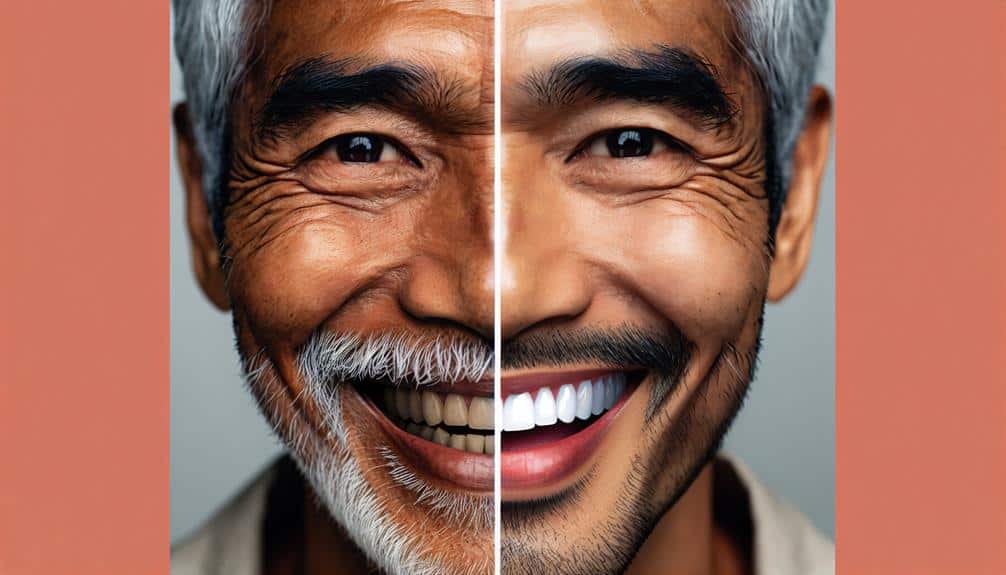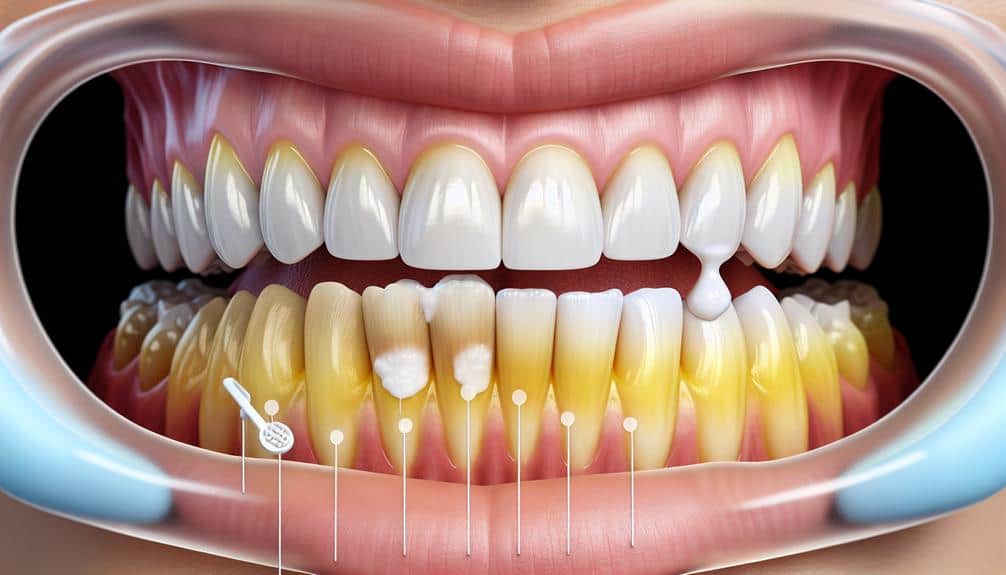Whitening aids genetic tooth discoloration by targeting and breaking down the chromophores in your enamel. This process addresses the molecular changes responsible for genetic discoloration. Not only does whitening enhance your appearance, but it also boosts your psychological well-being. Professional whitening treatments offer stronger agents tailored to effectively tackle genetic discoloration. For long-lasting effects, consider investing in these treatments. To maintain your results post-whitening, make sure you brush your teeth twice daily with a soft-bristled toothbrush, floss daily, limit staining foods and drinks, use whitening toothpaste, and schedule regular dental cleanings. Enhance your smile and confidence with the help of whitening!
Key Points
- Whitening reduces chromophores in enamel, improving discoloration caused by genetic variations.
- Targeted whitening breaks down molecules responsible for genetic discoloration in enamel structure.
- Enhances aesthetics and boosts confidence by addressing genetic tooth discoloration effectively.
- Whitening alters chromophore structure, targeting hereditary enamel rod arrangement issues.
- Professional whitening offers tailored treatments with potent agents for lasting results on genetic discoloration.
Understanding Genetic Tooth Discoloration
If you've ever wondered why some people have genetic tooth discoloration, it all comes down to variations in the genes responsible for tooth enamel formation. These genetic variations can lead to changes in the structure and composition of the enamel, resulting in discoloration that's inherited rather than acquired.
The reasons for genetic tooth discoloration are intricate and can involve a combination of genetic factors and environmental influences. While some genetic tooth discoloration can't be prevented due to its hereditary nature, there are certain preventive measures that can help reduce the risk of discoloration.
Prevention strategies for genetic tooth discoloration include maintaining good oral hygiene practices, avoiding habits like smoking or excessive consumption of staining foods and beverages, and regular visits to the dentist for professional cleanings and check-ups. Understanding the underlying reasons for genetic tooth discoloration is essential in developing effective prevention strategies to preserve the natural beauty of your smile.
Mechanism of Whitening on Genetics
Understanding how whitening treatments affect genetic tooth discoloration involves delving into the mechanisms through which whitening agents interact with the genetic variations influencing enamel coloration. The mechanism explanation lies in the ability of whitening agents to penetrate the enamel and break down the molecules that cause discoloration.
In genetic cases, where the tooth discoloration is inherent, these agents work by targeting the chromophores responsible for the color changes. The genetic impact on enamel coloration can lead to variations in the density and arrangement of enamel rods, affecting how light reflects off the teeth and influencing their color.
Whitening treatments help by altering the structure of these chromophores, reducing the concentration of pigments that cause discoloration. By understanding the mechanism through which whitening agents interact with genetic variations in enamel coloration, individuals can make informed decisions about how to address genetic tooth discoloration effectively.
Benefits of Whitening for Genetics
Whitening treatments offer important benefits for individuals with genetic tooth discoloration by effectively targeting and reducing the chromophores responsible for color changes in the enamel. By penetrating the enamel and breaking down these pigmented molecules, whitening procedures can lead to noticeable improvements in the appearance of discolored teeth. The aesthetic enhancements resulting from whitening can play a vital role in boosting your confidence and self-esteem.
When genetic factors contribute to tooth discoloration, traditional oral hygiene practices may not be sufficient to address the underlying cause. This is where whitening treatments become particularly advantageous. By specifically addressing the chromophores embedded in the enamel due to genetic predispositions, whitening procedures offer a targeted solution that can greatly improve the overall color and brightness of your teeth.
The ability of whitening treatments to enhance the aesthetics of genetically discolored teeth isn't only an aesthetic benefit but also a psychological one. Improving the appearance of your smile can have a profound impact on your self-image, ultimately boosting your confidence in social and professional interactions. Whitening for genetic tooth discoloration is a valuable tool in achieving both a brighter smile and a more positive self-perception.
Types of Whitening for Genetics
Utilizing advanced bleaching agents tailored to target specific genetic discoloration markers can greatly enhance the effectiveness of whitening treatments for individuals with inherent tooth color variations. When it comes to addressing genetic tooth discoloration, there are two main types of whitening options: home remedies and professional treatments.
Home remedies generally include over-the-counter products such as whitening toothpaste, strips, or trays. While these options may provide some improvement, they're often less potent and may not effectively target the specific genetic markers responsible for the discoloration.
On the other hand, professional treatments, such as in-office bleaching or custom trays provided by dentists, offer stronger bleaching agents and are tailored to individual needs. These treatments are more likely to deliver significant results for genetic tooth discoloration due to their higher concentration of active ingredients and professional application techniques.
For individuals with genetic tooth discoloration, investing in professional whitening treatments can lead to more noticeable and long-lasting results compared to relying solely on home remedies.
Maintaining Results Post-Whitening
To maintain the results achieved post-whitening, it's essential to establish a consistent oral care routine that includes gentle brushing, flossing, and regular dental check-ups. Here are some key steps to help you preserve your bright smile and prevent stains:
- Brush Twice Daily: Use a soft-bristled toothbrush and fluoride toothpaste to gently clean your teeth, ensuring all surfaces are thoroughly brushed.
- Floss Daily: Flossing removes plaque and debris from between teeth, preventing discoloration and decay in those hard-to-reach areas.
- Limit Staining Foods and Drinks: Reduce consumption of coffee, tea, red wine, and other staining substances to maintain your whitened teeth.
- Use Whitening Toothpaste: Incorporate a whitening toothpaste into your routine to help combat surface stains and maintain the results of your whitening treatment.
- Regular Dental Check-Ups: Schedule bi-annual dental visits for professional cleanings and check-ups to address any potential issues early on and keep your smile bright and healthy.
Frequently Asked Questions
Can Genetic Tooth Discoloration Be Completely Reversed With Whitening Treatments?
Genetic tooth discoloration can show improvement with whitening treatments, but complete reversal may not always be possible. Long term effectiveness varies, and alternatives like veneers or bonding may be considered for more permanent changes.
Are There Any Potential Risks or Side Effects Associated With Whitening Treatments for Genetic Tooth Discoloration?
When contemplating whitening for genetic tooth discoloration, it's essential to acknowledge potential risks and side effects. Sensitivity and gum irritation are typical, but consulting a dentist for personalized guidance can help mitigate these concerns effectively.
How Long Do the Results of Whitening Treatments Typically Last for Genetic Tooth Discoloration?
For genetic tooth discoloration, whitening treatments can last from a few months to a few years. Maintenance plays an essential role in long-term efficacy. Consider alternative treatment options like veneers for more permanent results if whitening doesn't provide lasting effects.
Is It Possible for Genetic Tooth Discoloration to Worsen Over Time, Even With Whitening Treatments?
Over time, genetic tooth discoloration can potentially worsen despite whitening treatments. Possible causes include underlying genetic factors influencing enamel structure. Long term effects may lead to continued discoloration even with whitening interventions, necessitating ongoing management.
Are There Any Alternative Treatments or Solutions for Genetic Tooth Discoloration Aside From Whitening?
When it comes to genetic tooth discoloration, exploring alternative treatments beyond whitening can be beneficial. Natural remedies, dietary changes, cosmetic dentistry like enamel bonding are options to contemplate for addressing genetic tooth discoloration effectively and thoroughly.



